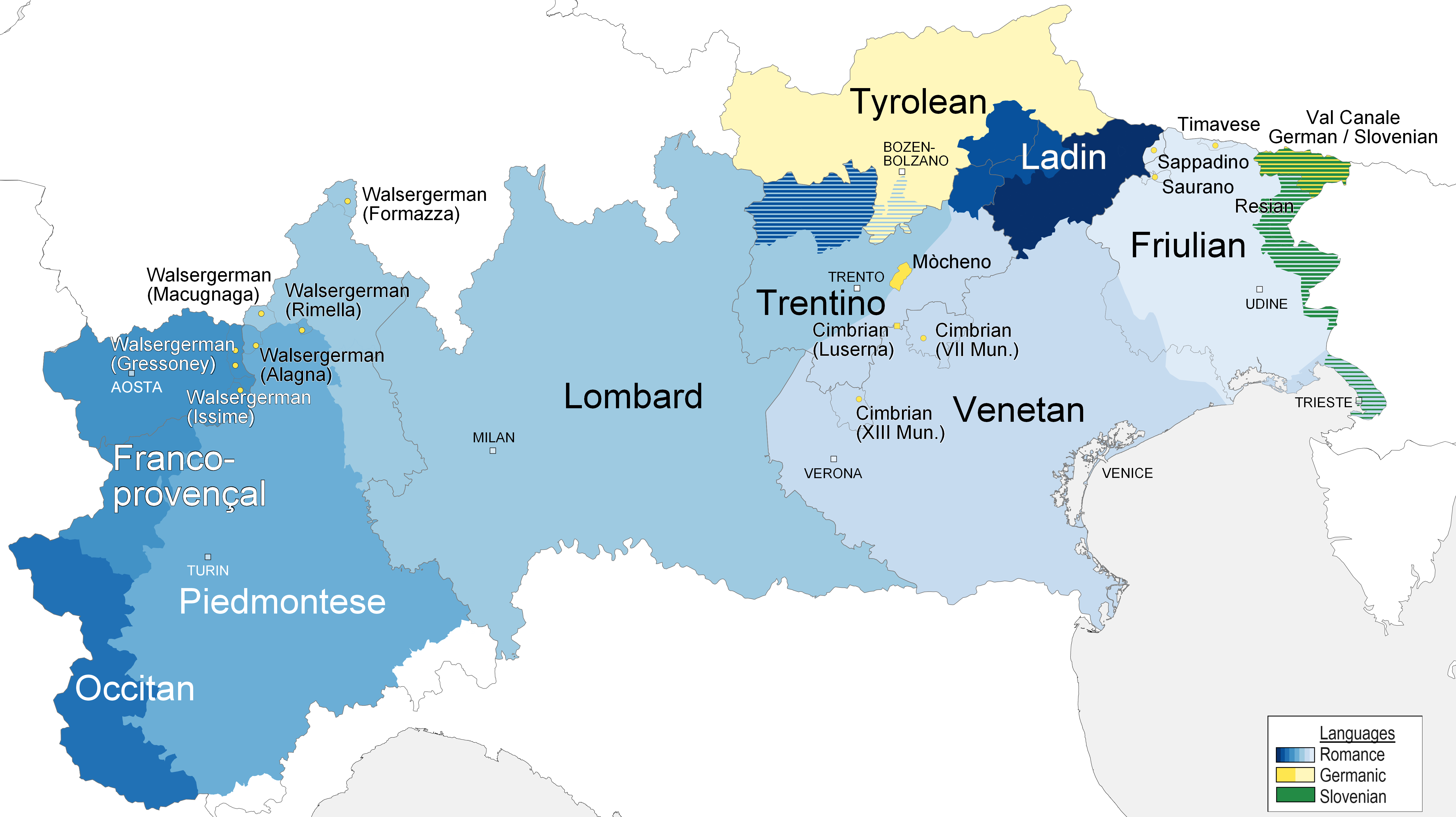AlpiLinK collects data for all linguistic varieties spoken in the Italian Alps, that are part of the Germanic, (Rhaeto-)Romance or Slavic language families. Have a look at the map below to see which varieties are present and where they can be found. Or scroll down and find them all listed. Many of the names on the map are macrolabels commonly used in the areas in which they are placed. They do not denominate a homogenous linguistic variety, but rather a group of dialects which share some features, but still maintain a significant amount of linguistic variation within each group.
Our varieties

The name Cimbrian refers to the varieties spoken in the Germanic language islands of Luserna/Lusérn, in the province of Trento (which still has several hundred speakers), Giazza/Ljetzan in the historical area of the “13 Comuni” (13 Municipalities) in the province of Verona (a few dozen speakers) and Roana/Robaan in the historical area of the “VII Comuni” (7 Municipalities) of the Asiago Plateau, in the province of Vicenza (not more than 10 speakers).
The Francoprovençal domain extends in Piedmont, between the Sangone Valley and the Soana Valley, and throughout the territory of the Aosta Valley, with the exclusion of the three Walser colonies of the Lys Valley. Francoprovençal varieties are also historically spoken in Central and Eastern France and Western Switzerland.
Friulian or Friulan (furlan in Friulian) is a language spoken in the historical Friuli region in northeastern Italy confined in the north by Austria and in the east by Slovenia. It developed around 1000 AD from Vulgar Latin spoken in the Aquileia region.
Ladin is spoken in some Alpine areas of Trentino-South Tyrol and Veneto, where it is a direct continuation of the local variant of Vulgar Latin. The name Ladin was initially used in a very narrow sense, reserved primarily for the Val Badia variety, but it was later extended to the entire Rhaeto-Romance group of the Dolomite valleys.
The Lombard dialects belong to the Gallo-Romance dialects. Outside of Lombardy, they are also spoken in Switzerland in Canton Ticino and in the Italian-speaking parts of the Canton of Graubünden, in the Piedmontese province of Novara between the Sesia and Ticino rivers, and in the western part of Trentino.
Mòcheno is a Germanic variety spoken in Trentino, in the Fersina Valley, ca. 20 km east of the city of Trento. Speakers, in addition to the term Mòcheno also use de inger sproch (‘our language’) to refer to their own variety. The first German settlers established themselves in the Fersina Valley around the 13th century and were originally from Tyrol and from areas next to the Fersina Valley that were already colonized by German-speaking communities.
Occitan varieties are spoken by about 10-15,000 people in the Piedmont valleys of the provinces of Cuneo and Turin between the high Val di Susa in the north and the Val Vermenagna in the south. This area represents the eastern extension of a larger area that extends throughout the entire southern part of France. The Occitan varieties spoken in Piedmont, locally called patois or parlar a nosto modo ‘speaking in our way’, are characterized by a significant geographic variation. Due to the lack of a unifying centre, no standard variety has ever emerged.
The Piedmontese language includes varieties spoken in a wide vertical belt in the central part of the Piedmont region. Among these, the most prominent is the variety spoken in Turin. This regional koine, commonly referred to as “Piedmontese”, has spread not only to major centres (such as Ivrea, Lanzo Torinese, Susa, Pinerolo, Dronero, and Cuneo), but also to the communities of Occitan and Francoprovençal speakers.
Resian is part of the Slovenian minority varieties protected by the 482/1999 law. From the perspective of Slovenian dialectology, the local varieties of the Resia Valley constitute the most northwestern group of Littoral dialects (primorščino narečje) (see SLA, p. 11-14).
The village of Plodn (in Italian: Sappada; in German: Pladen), where the German minority language Sappadino is spoken, is located on the upper reaches of the Piave River in the Carnic Alps. The first detailed written source – a document dated 1296 – refers to a settlement already existing “from time immemorial”, which must therefore have occurred decades earlier.
In Sauris (Germ. Zahre) in Northeastern Italy a German minority language is spoken: de zahrar sproche. The community of Sauris is located in the historical cultural landscape of Friuli and belongs to the province of Udine in the autonomous region of Friuli-Venezia Giulia. Sauris is situated at an altitude of about 1300 metres above the Tagliamento valley, in an area where language contact is the norm rather than the exception.
Timau (local name: Tischlbong) lies at an altitude of 820 m in the northeast of Italy on the border with Austria. According to oral tradition, miners from the Carinthian Gailtal valley and from the Weissensee settled there before the end of the 13th century – not far from the old Roman road Via Julia Augusta, which led north from Aquileia and connected Carnia and Carinthia.
The Tyrolean dialects are spoken in Austria, in the Bundesland Tirol, and in Italy in the Autonomous Province of Bolzano-Alto Adige (South Tyrol). They belong to the larger group of the Southern Bavarian dialects.
The dialects spoken in the province of Trento are of Romance origin. Its varieties are Venetan in the eastern part of the province and Lombard in the Western part; the central area has mixed characteristics; in the lower Adige Valley there is a transition dialect between the central Trentino and the Verona variety.
The Val Canale, which borders Austria and Slovenia, is now part of the autonomous region of Friuli Venezia Giulia in the far northeast of Italy. The municipalities of Tarvisio/Tarvis, Malborgetto-Valbruna/Malborgeth-Wolfsbach and Pontebba/Pontafel in particular are plurilingual communities that are officially recognized as quadrilingual. In addition to the state language Italian and the regional official language Friulian, the population uses the historical dialect based on South Bavarian, which is a continuation of Carinthian, as well as Slovenian.
Slovenian is one of the minority languages officially recognized by Italy through law 482/1999. The northernmost region where Slovenian is spoken is the Val Canale (Slovenian: Kanalska dolina), which is quadrilingual: Slovenian is part of speaker’s individual repertoires alongside German, Italian and Friulian.
The Veneto dialects cover a large area of Northeastern Italy, and are primarily spoken in the Veneto region, as well as large areas of Trentino and Friuli. Due to large-scale emigration from the regions in the 19th and 20th century, they also have a strong presence in the overseas Italian diasporas.
The Highest Alemannic Walser varieties are spoken in a mountain area which extends across the borders of Italy, Switzerland and Austria. In Italy, Walser varieties are actually spoken in small villages placed in North Eastern Piedmont and South Eastern Aosta Valley, and represent the western border of the Walser Area.
